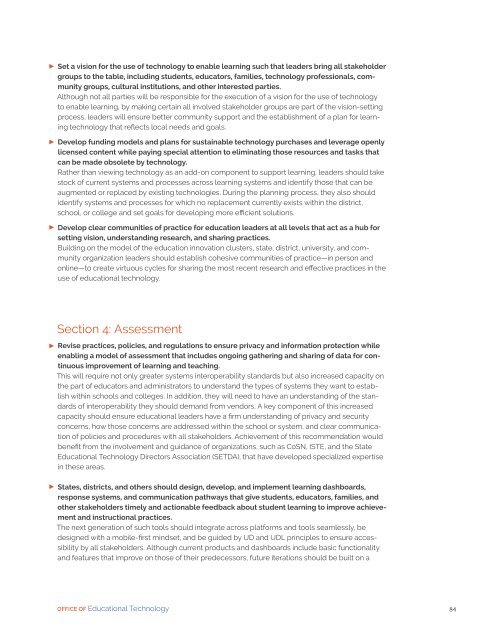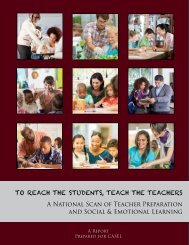Future Ready Learning
7m3sdJ
7m3sdJ
Create successful ePaper yourself
Turn your PDF publications into a flip-book with our unique Google optimized e-Paper software.
Set a vision for the use of technology to enable learning such that leaders bring all stakeholder<br />
groups to the table, including students, educators, families, technology professionals, community<br />
groups, cultural institutions, and other interested parties.<br />
Although not all parties will be responsible for the execution of a vision for the use of technology<br />
to enable learning, by making certain all involved stakeholder groups are part of the vision-setting<br />
process, leaders will ensure better community support and the establishment of a plan for learning<br />
technology that reflects local needs and goals.<br />
Develop funding models and plans for sustainable technology purchases and leverage openly<br />
licensed content while paying special attention to eliminating those resources and tasks that<br />
can be made obsolete by technology.<br />
Rather than viewing technology as an add-on component to support learning, leaders should take<br />
stock of current systems and processes across learning systems and identify those that can be<br />
augmented or replaced by existing technologies. During the planning process, they also should<br />
identify systems and processes for which no replacement currently exists within the district,<br />
school, or college and set goals for developing more efficient solutions.<br />
Develop clear communities of practice for education leaders at all levels that act as a hub for<br />
setting vision, understanding research, and sharing practices.<br />
Building on the model of the education innovation clusters, state, district, university, and community<br />
organization leaders should establish cohesive communities of practice—in person and<br />
online—to create virtuous cycles for sharing the most recent research and effective practices in the<br />
use of educational technology.<br />
Section 4: Assessment<br />
Revise practices, policies, and regulations to ensure privacy and information protection while<br />
enabling a model of assessment that includes ongoing gathering and sharing of data for continuous<br />
improvement of learning and teaching.<br />
This will require not only greater systems interoperability standards but also increased capacity on<br />
the part of educators and administrators to understand the types of systems they want to establish<br />
within schools and colleges. In addition, they will need to have an understanding of the standards<br />
of interoperability they should demand from vendors. A key component of this increased<br />
capacity should ensure educational leaders have a firm understanding of privacy and security<br />
concerns, how those concerns are addressed within the school or system, and clear communication<br />
of policies and procedures with all stakeholders. Achievement of this recommendation would<br />
benefit from the involvement and guidance of organizations, such as CoSN, ISTE, and the State<br />
Educational Technology Directors Association (SETDA), that have developed specialized expertise<br />
in these areas.<br />
States, districts, and others should design, develop, and implement learning dashboards,<br />
response systems, and communication pathways that give students, educators, families, and<br />
other stakeholders timely and actionable feedback about student learning to improve achievement<br />
and instructional practices.<br />
The next generation of such tools should integrate across platforms and tools seamlessly, be<br />
designed with a mobile-first mindset, and be guided by UD and UDL principles to ensure accessibility<br />
by all stakeholders. Although current products and dashboards include basic functionality<br />
and features that improve on those of their predecessors, future iterations should be built on a<br />
OFFICE OF Educational Technology<br />
84



